How do Organisms Reproduce Class 10 Notes is part of Class 10 Science Notes for Quick Revision. Here we have given NCERT Class 10 Science Notes Chapter 8 How do Organisms Reproduce. According to new CBSE Exam Pattern, MCQ Questions for Class 10 Science pdf Carries 20 Marks.
CBSE Class 10 Science Notes Chapter 8 How do Organisms Reproduce
Asexual Reproduction
- It involves only one parent.
- There is no formation and fusion of gametes.
- The young ones formed are almost identical to each other as well as to the parent cell.
- Asexual reproduction generally occurs during favourable environmental conditions and when there is an abundance of food.
- It is a faster method of reproduction.
Types of Asexual Reproduction is Unicellular Organism
(i) Binary Fission:
Seen in bacteria, protozoa like Amoeba, Paramecium. (In these first pseudopodia withdrawn (karyokinesis) the nucleus of the parent cell divides and then the cytoplasm divides (cytokinesis) resulting in the formation of two daughter cells). It occurs during highly favourable conditions. The cell division can occur in any plane as in case of Amoeba. However, organisms like Leishmania. (cause Kala-azar), which have a whip like flagella at one end, binary fission occurs in a definite orientation in relation to the flagellum.
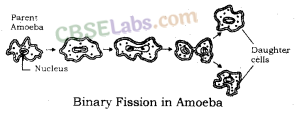
Cytokinesis: Division of cytoplasm.
Karyokinesis: Division of Nucleus.
(ii) Multiple Fission:
Seen in Plasmodium, (a malarial parasite). In this during unfavourable conditions, the parent cell develops a thick resistant wall around itself forming a cyst. Within the wall, the cytoplasm divides many times to form many plasmodia. When conditions become favourable, the cyst wall breaks and the Plasmodium are released.
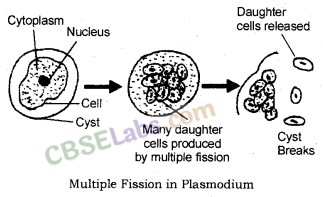
(iii) Budding:
Seen in Yeast (a fungus). The parent yeast cell develops a protrusion or an outgrowth at its upper end. The nucleus of the parent cell divides and one of them moves into the outgrowth which grows bigger and finally separates from the parent cell to lead an independent existence. Very often if the conditions are highly favourable, a chain of buds is formed.
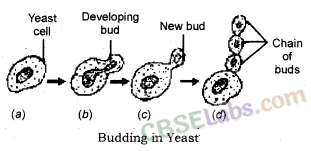
Types of Asexual Reproduction in Multicellular Organisms :
(i) Fragmentation:
Seen in multicellular organisms which have a relatively simple body organisation like Spirogyra. Spirogyra has a filamentous body. (If it breaks into smaller pieces or fragments). Each fragment has the capacity to form a new individual.
However, all multicellular organisms cannot show cell-by-cell division as cells from tissues which form organs. These organs are placed at definite positions in the body. Hence, they need to use more complex methods of reproduction.
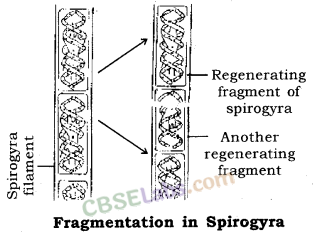
(ii) Regeneration:
It is the ability of organisms to develop their lost parts. Some organisms show have high regenerative capacity it is also a means of reproduction for example; Planaria. (Regeneration is carried out by specialized cells which redivide to form a mass of cells from which different cells undergo changes to become different cell types and tissues. These changes occur in an organized sequence known as development).
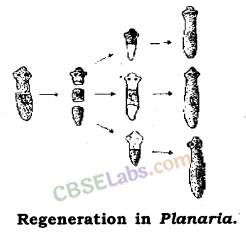
(iii) Budding:
Seen in Hydra. Parent Hydra develops a bud at its lower end. This grows in size and finally breaks off to live independently.
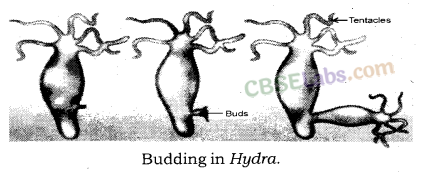
(iv) Spore Formation:
Seen in Rhizopus (a fungus). Rhizopus body is made up of thread-like structures called hyphae. The erect hyphae bear sporangia inside which reproductive structures called spores are formed. Spores are asexually reproducing bodies having a thick protective wall. They are produced during unfavourable times and help to tide over the unfavourable environmental conditions. When the spores fall on a suitable medium, each one forms a new individual.
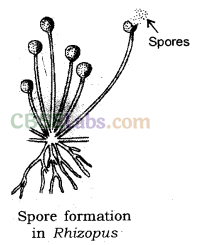
(v) Vegetative Propagation: Method by which plants reproduce by their vegetative parts such as roots, stems, and leaves.
Types of Vegetative Propagation: It is two types
- Natural vegetative propagation.
- Artificial vegetative propagation (Tissue culture).
Mint reproduces naturally by roots. Sugarcane, jasmine by stems and Biyophyllum by leaves. In biyophyllum buds are produced in the notches along the leaf margins and when they fall on the soil, they develop into new plants.
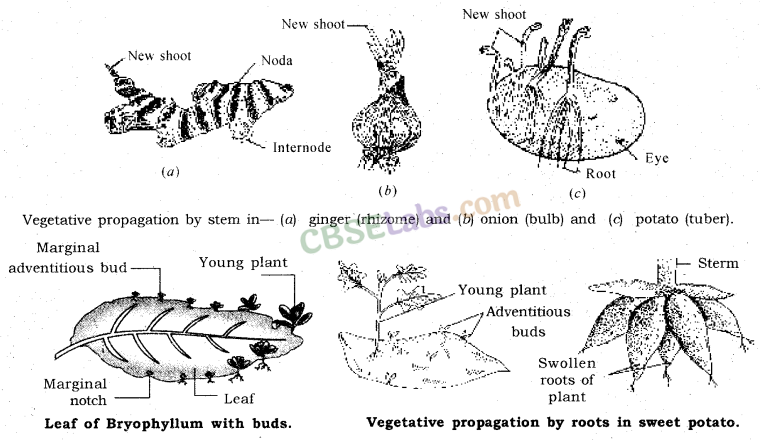
Importance of Vegetative Propagation
- Plants can bear flowers and fruits earlier.
- Plants which have lost the ability to produce viable seeds can also reproduce by vegetative propagation.
- All plants are genetically almost similar to the parent plant.
- Seedless varieties can be obtained.
- The property of vegetative propagation is used by horticulturists in developing methods like layering, grafting to grow many plants like sugarcane, roses, or grapes.
Tissue Culture: The technique of developing new plants from a cell or tissue in a nutrient medium under aseptic conditions. The cell or tissue is placed in a nutrient medium where it forms a mass of cells called callus. This callus is then transferred to another nutrient medium where it differentiates and forms a new plant.
Sexual Reproduction:
Sexual reproduction in plants, Sexual reproduction in human beings. The mode of reproduction that takes place with the involvement of two individuals of two different sexes i.e. male and female.
During sexual reproduction, male organism having male sex organs produces male gametes i.e. sperms which are small and motile and the female organism having female sex organs produces ova which are generally large and store food. Male and female gametes fuse to form a zygote that grows into a new organism.
Significance of Sexual Reproduction :
- Sexual reproduction involves DNA as well as cellular apparatus of two different organisms which promotes diversity of characters in the offspring.
- Since gametes are derived from two different organisms, it results in a new combination of genes which increases the chances of genetic variations.
- Sexual reproduction results in the origin of. new species.
- Sexual reproduction involves division in the sex organs that reduces the DNA matter to half so that the zygote formed after fusion has the same amount of DNA as the parents it maintains DNA in a species.
Limitation of Sexual Reproduction: Sexual reproduction involves the process of combining DNA from two different organisms which may bring some undesirable features also.
Sexual reproduction in flowering plants
- The reproductive parts are present in the flower.
- The parts of the flower are sepals, petals, stamens and carpels.
- Sepals are green structures that protect the inner parts when the flower is in bud stage.
- Petals are colourful and attract the insects for pollination.
- Stamens are male reproductive parts and produce pollen grains that contain male gametes. Each stamen has two parts—
- Filament i.e. stalk and Anther i.e. swollen top part which has large number of pollen grains.
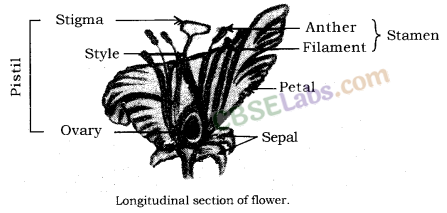
The carpel is the female reproductive part and produces ovules that contain female gametes. It has three parts—Stigma which is top sticky part and receives pollen grains during pollination. Style which is the middle long part and ovary which is the swollen part and contains ovules. Each ovule has an egg cell i.e. female gamete.
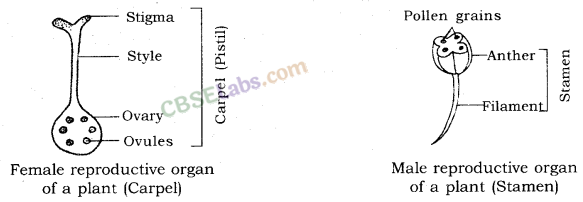
The flowers may be bisexual i.e. having both stamens and carpels for example; Mustard China Rose (Hibiscus).
The flower may be unisexual i.e. paving either stamens or carpels for example; Papaya, Watermelon.
Pollination:
The process of transfer of pollen grains from an anther to the stigma of the flower is pollination. Two types of pollination are:
(i) Self-pollination:
The transfer of pollen grains from the anther to the stigma of the same flower or another flower of the same plant.
(ii) Cross-pollination:
The transfer of pollen grains from the anther to the stigma of another flower or another flower of a different plant of the same species. It generally takes place with the help of some agents like insects, birds, wind and water.
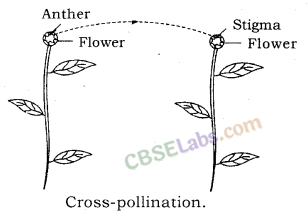
Fertilization:
Fertilization is the process of fusion of male and female gamete to form a zygote during sexual reproduction. Pollination is followed by fertilisation in plants. The events are
Pollen grains land on the stigma of the ovary.
Pollen tubes grow out of the pollen grains, travel through the style and reach the ovary, through micro pyle.
Pollen tube has two male germ cells. Each ovule has two polar nuclei and a female germ cell (egg).
Pollen tube releases two male germ cells inside the ovule, one of them fuses with female germ cell and forms a zygote which grows into the baby plant i.e. embryo, the fusion is known as syngamy. The other male germ cell fuses with two polar nuclei, the process is known as triple fusion. So in flowering plants two fusions take place during fertilisation. It is called double fertilisation.
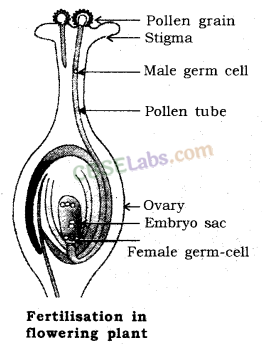
Post-fertilisation changes: After fertilisation the following changes takes place in the flower.
Zygote divides several times and forms an embryo inside the ovule.
- The ovule develops a tough coat and changes into the seed.
- The ovary grows rapidly and ripens to form a fruit.
- Petals, sepals, stamens, style and stigma shrivel and fall off.
Seed and its parts: The advantage of seed is that it protects the future plant i.e. embryo.
Seed has two parts: Cotyledons and Embryo Cotyledons store food for the future plant.
Embryo has two parts:
plumule and radicle. Plumule develops into shoot and radicle develops into root.
The process of development of a seedling from the embryo under appropriate conditions is known as germination.
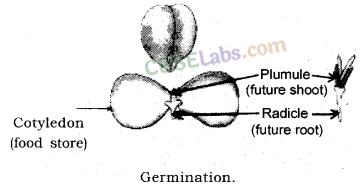
Reproduction in Human Being: Human beings show sexual reproduction. Male parent produces male gametes called sperms. Female parent produces female gametes called ova. Sperms have tail and are therefore, motile. They are produced in large numbers in the testes. Ovum is bigger, non-motile and only one ovary produces one ovum in one month. There is no food stored in the sperms whereas ova contain stored food. Both the gametes are microscopic unicellular and have half the number of chromosomes as compared to the body cells.
Human beings become reproductively active from the onset of puberty. Puberty is the period during adolescence when the rate of general body growth begins to slow down and reproductive tissues begin to mature. Onset of puberty in human males is between 11 to 13 yrs of age, while in human females is between 10 to 12 yrs. of age. Puberty is associated with many physical, mental, emotional and psychological changes in boys and girls which occur slowly over a period of time. These are called secondary sexual characters. For instance thick dark hair start growing in new parts of the body such as arm pits and genital area between the thighs. Thinner hair appear on legs, arms and face. Skin becomes oily and pimples may appear on the face. Individuals become more conscious of their bodies become more independent, more aggressive etc.
In case of boys beard and mustache start appearing, voice begins to crack, reproductive organs develop and start producing releasing sperms.
In case of girls, breast size begins to increase, skin of the nipples darkens, menstruation starts.
The act of mating between the male and female partner is termed as copulation.
Male Reproductive System:
Male reproductive system consists of the following components
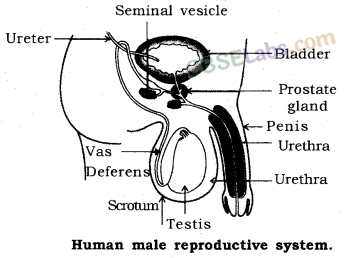
- 1 pair of testes
-
A system of ducts
- Epididymis
- Vas deferens or the sperm duct
- Urethra
-
A system of glands
- Seminal vesicles
- Prostrate gland
- Cowper’s gland
- A copulatory organ called a penis.
One pair of testes are present in a bag-like structure called scrotum which lies outside the abdominal cavity, hence they are extra abdominal in position. This is so because the testes have to be maintained at 1-3 degree lesser temperature than the body in order to produce functional sperms.
Functions of testes
- To produce male gametes i.e. the sperms.
- To produce a male reproductive hormone called testosterone which is responsible for producing sperms as well as secondary sexual characteristics in males.
Attached to each testis is a highly coiled tube called epididymis. The sperms are stored here and they mature in the epididymis.
Each epididymis leads into the sperm duct or the vas-deferens. Each vas-deferens rises up and enters into the abdominal cavity. It unites with the duct coming from the urinary bladder to form a common duct called urethra which passes through the penis and opens to the outside. Along the way the ducts of the three glands also open and pour their secretions into the vas deferens.
Function of the vas-deferens: It is meant for the passage of the sperms in the male body.
Functions of the glands:
They produce different secretions which provide nutrition as well as medium for locomotion to the sperms.
The secretions of the three glands along with the sperms is known as semen.
Function of the urethra: It is the common passage for both semen and urine from the body to. the outside.
Penis: It is the organ which is used to introduce semen into the female body. It is richly supplied with blood vessels.
Female Reproductive System:
It consists of the following components
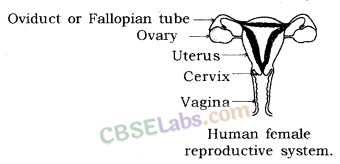
- 1 pair of ovaries
- 1 pair of fallopian tubes or oviducts
- A uterus/womb
- A vagina/birth canal.
Each ovary is almond shaped and present inside the abdominal cavity. At the time of birth each girl child already contains thousands of immature ova. These ova start maturing only from the time of puberty. Only one ovum is produced by one ovary in one month and each ovary releases an ovum in alternate months. The release of an ovum from the ovary into the abdominal cavity is known as ovulation.
Functions of ovary
- To produce and release ova
- To produce female reproductive hormones: estrogen and progesterone.
There are two fallopian tubes. The end lying close to the ovary has finger like structures called fimbriae. The two fallopian tubes unite to form an elastic bag like structure called uterus.
Function of the fallopian tubes:
It is the site of fertilization between the male and the female gametes and formation of the zygote early embryo.
The inner lining of the uterus is richly supplied with blood vessels and is known as endometrium. The narrow end of the uterus is called cervix.
Function of the uterus: The embryo formed in the fallopian tube comes down and gets attached to the endometrium (implantation) and develops for the next nine months till the baby is delivered.
Vagina: The uterus opens into the vagina through the cervix. The vagina is a muscular tube through which the baby is delivered at the end of nine months. It also serves as the canal for receiving the semen at the time of copulation.
The semen is discharged into the vaginal tract during copulation. The sperms travel upwards and reach the fallopian tube where one sperm fuses with the ovum to form the zygote. The zygote divides and redivides as it descends into the uterus and the embryo gets implanted in the endometrium. The endometrium thickens so as to receive the embryo.
The embryo gets nutrition from the mother’s blood with the help of a special tissue called placenta, which is a disk-like structure embeded in the uterine wall. It contains finger-like villi on the embryo side, while on the mother’s side blood spaces surround the villi. Villi provides a large surface area for glucose and oxygen to pass from the mother to the developing embryo and the wastes to pass from the embryo to the mother through the placenta. When the embryo starts resembling a human is formed, it is termed as a foetus. The foetus continues
to develop inside the uterus for almost nine months after which the baby is delivered as a result of rhythmic contractions of the uterine muscles.
Menstruation: It is the loss of blood, mucous along with the unfertilized ovum and the ruptured cells and tissues of the endometrium through the vagina of the female. It is a 28-day cycle which occurs in every reproductively active female (from puberty). The flow of blood continues for 2 to 8 days. If the ovum does not get fertilized, then the endometrium starts sloughing off and there is loss of blood and mucous etc. through the vagina. In case the ovum gets fertilized, then the endometrium becomes thick and spongy for nourishing the embryo and hence menstruation does not occur. A lady with a developing embryo in her womb is termed as pregnant. The beginning of menstruation at puberty is known as menarche. The stopage of menstruation when the woman is 45-55 yrs of age is called menopause.
Reproductive Health:
Sexually transmitted diseases and birth control.
A number of diseases occur as a result of sexual intercourse if one of the partners is infected. These are known as sexually transmitted diseases (STD’s). They can be caused by bacteria for example; syphilis, gonorrhoea; or caused by a virus for example; HIV-AIDS, warts etc. The transmission of these diseases can be avoided by using birth control measures such as wearing a condom during the sexual act.
Birth control measures: They can be mechanical, chemical and surgical.
Mechanical methods:
These are used to prevent the passage of semen to the follopian tube :
(i) Use of condoms: Condoms are thin rubber tubes worn over the penis before sexual intercourse. The semen gets collected in this and is not discharged into the vagina.
(ii) Diaphragm: It is a thin rubber fixed over a flexible metal ring which is fitted over the cervix in a woman’s body by a doctor.
(iii) Intra Uterine Contraceptive Device (IUCD) or loop: It is inserted in the uterus and its insertion causes certain secretion which prevents the implantation of the embryo in the uterine wall.
Both methods (ii) and (iii) cause side effects.
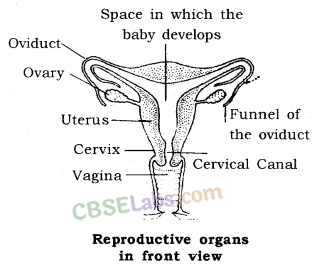
Chemical methods
- Use of spermicides: These are strong sperm-killing chemicals available in the form of creams, jellies etc. which are injected into the vagina just before copulation.
- Oral contraceptive pills: These are hormonal pills which prevent ovulation but do not stop menstruation.
Surgical methods
- Vasectomy: It involves cutting and ligating the vas deferens in males.
- Tubectomy: It involves cutting and ligating Reproductive organs the fallopian tubes in females.
- Medical termination of pregnancy (MTP) or abortions is carried out to eliminate the developing embryo. This practice can, however, be misused to carry out female foeticide which involves the killing of the female foetus. It should be avoided at all cost as it disturbs the male-female ratio in a population.
Reproduction: It is the process by which living organisms produce new individuals similar to themselves.
- Reproduction ensured continuity of life on earth.
- It is a bridge to hereditary transmission.
- It involves a continuation of characters from the parents to daughter cells by copying of DNA (Deoxyribose Nucleic Acid) molecules present in the chromosomes of the cell.
- Copying of DNAs is also not a foolproof exercise, even minute changes bring about variation in the blue print of the offsprings.
- The useful variations are retained while the harmful ones do not go beyond.
- Actually, variations help the species to withstand drastic environmental changes, thus save the species from becoming extinct and promotes its survival for a longer time.
- This inbuilt tendency of variation is the “basis” for Evolution.
Asexual Reproduction:
It is extremely useful as a means of rapid multiplication. It is common in lower plants and animals.
Different forms of Asexual Reproduction:
- Fission: The parent cell divides/splits into two daughter cells —Binary fission and splits into many cells —Multiple fission.
- Budding: A new organism is produced as an outgrowth of the parent body part.
- Spore Formation: Spores are small, the bulb-like structure which develops at the top of the erect hyphae of the fungus-plant, when released into the air germinate, into new individuals after landing into food or soil.
- Fragmentation: It is the accidental process when the broken pieces of an organism (fragments) grows into a complete organism. Example, fragmentation in Spirogyra.
- Regeneration: When simple animals like a hydra, planaria develop a new individual from their broken older part it is known as regeneration. It is carried out by specialised cells which grow large numbers of cells.
Vegetative Propagation:
A mode of reproduction in which parts like the stem, root, leaves develop into new plants under favourable conditions.
Benefits:
- Plants can bear flowers, fruits more quickly than those produced from seeds.
- Growing banana, orange, rose, jasmine that have lost the capacity to produce seeds.
- The genetical similarity is maintained in the plants. Example, sugarcane, rose, grapes by layering or grafting.
Sexual Reproduction: When reproduction takes place as a result of the fusion between two gametes, one from each parent, it is called sexual reproduction.
- This process of fusion between two gametes is called fertilization.
- The formation of gametes involves an exchange of chromosomal (genetic) fragments between homologous chromosomes causing genetic recombination which leads to variation.
Sexual Reproduction in Plants: It occurs mostly in flowering plants.’ In fact, flowers are the reproductive organ of plants.
- Pollen grains of a flower transfer to the stigma of the carpel of the same flower (Self-Pollination) or to the carpel of another flower (Cross-Pollination).
- This transfer of pollens is achieved by agents like wind, water or animals. After pollination, the pollen grains reach the egg cell in the form of a pollen tube.
- Fertilization. The fusion between the pollen grain and female egg cell. It occurs inside the ovary. The zygote is produced in this process.
- The zygote divides several times to form an embryo within the ovule. The ovule develops a rough coat and is converted into a seed.
- Ovary grows rapidly and ripens to form fruit, while the seed contains the future plant or embryo which develops into a seedling under suitable conditions. This process is known as Germination.
Reproduction in Human Beings:
- Humans use a sexual mode of reproduction.
- It needs sexual maturation which includes the creation of the germ cells, i.e., egg (ova) in the female and sperm in the male partner and this period of sexual maturation is called Puberty.
- Human beings have a well-developed male and female reproductive system.
-
The formation of the male germ cell (sperms) takes place in the testes (male reproductive organ). Actually, a pair of testes are located inside scrotum situated outside the abdominal cavity. It is meant to keep a relatively low temperature needed for the production of sperms by testes. Testes release a male sex hormone called testosterone whose function is to:
- regulate the production of sperms;
- brings about changes in appearance seen in boys at the time of puberty; and
- the sperms along with the secretion of the prostate gland and seminal vesicle, together constitute semen, which is released and made to enter into the female genital tract during Copulation.
Female Reproduction System:
- The female germ cells or eggs are made in the ovaries, a pair of which is located in both sides of the abdomen.
- When a girl is bom, the ovaries already contain thousands of immature eggs. At the time of puberty, some of these eggs start maturing. One egg is produced every month by one of the ovaries.
- The egg is carried from the ovary to the womb through a fallopian tube. These two fallopian tubes unite into an elastic bag like structure known as the uterus.
- The uterus opens into the vagina through the cervix.
- Fertilization occurs in the fallopian tube of the female genital tract.
- The fertilized egg also called zygote gets implanted in the lining of the uterus, and starts dividing. The uterus is richly supplied with blood to nourish the growing embryo.
- If the zygote is not formed, the inner wall of uterus breaks which causes bleeding through vagina. This process is called Menstruation. It occurs at a regular interval of 28 days.
- The embryo gets nutrition from the mother’s blood with the help of a special tissue called Placenta.
- Placenta provides a large surface area for glucose and oxygen to pass from the mother to the embryo. Similarly the wastes from developing embryo are removed to mother’s blood through placenta.
- The child is bom as a result of rhythmic contractions of the muscles in the uterus after nine months (36 weeks) of development inside the mother’s womb, called Gestation Period.
- The sexual cycle in a woman continues upto the age of 45 to 50 years. After that the ovaries do not release eggs. This stage is called Menopause. It also marks the end of menstruation in the woman.
Reproductive Health: Reproductive health means total well-being in all aspects of reproduction, z.e., physical, emotional, social and behavioural.
Contraception: It is the avoidance of pregnancy through different methods—Natural methods, Barrier method, Oral contraceptives, Surgical methods.
Advantages of contraception: Help in birth control, prevent sexually transmitted diseases, prevent unwanted pregnancies, keep population explosion in check.
1. Reproduction is the process by which a living organism is able to produce new individuals of its own kind. Unlike other life processes such as nutrition, respiration, etc., it is not essential to, maintain the life of an individual organism. But it is important for the existence and continuity of the species.
2. Reproduction involves the creation of DNA copy and additional cellular apparatus by the cell involved in the process.
3. The process of DNA copying leads to variations. This inbuilt tendency for variations during reproduction is the basis for evolution.
NCERT Solutions for Class 10 Science Chapter 8
4. Living organisms’ reproduce mainly through :
- Asexual reproduction
- Sexual reproduction
5. ASEXUAL REPRODUCTION
(a) Single ceiled organisms reproduce through following ways:
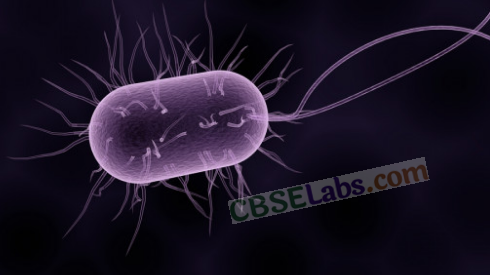
(ii) Budding (also by multicellular organisms)
(iii) Spore formation (also by multicellular organisms)
(b) Asexual reproduction by multicellular organisms:
(i) Fragmentation and Regeneration
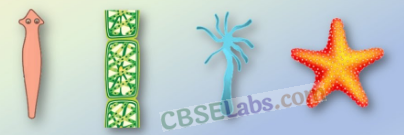
6. Fission:
In unicellular organisms when cell becomes fully mature, it splits into two or more parts. It is called the fission. In organisms such as Amoeba, splitting can take place in any plane. But in organisms like Leishmania, having whip like structure at one end of the cell, binary fission occurs in a definite orientation in relation to these structures.
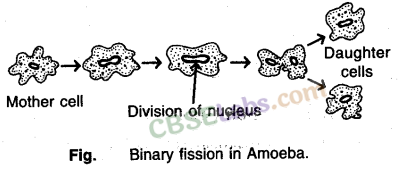
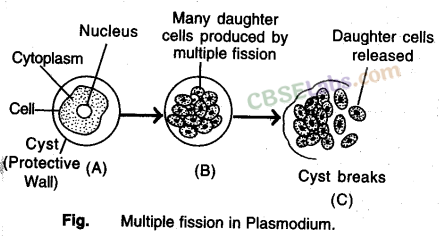
7. Regeneration : It is the ability to give rise to new organism. When the individual is cut or broken up into many pieces. It can be seen in Hydra and Planaria and is known as regeneration.
Regeneration is carried out by specialised cells. These cells proliferate and rqgkeJarge numbers of cells. From this mass of cells, different cells undergo changes to become various cell types and tissues. These changes take place in an organised sequence referred to as ” development. However, regeneration is not the same as reproduction, since most organisms would not normally depend on being cut up to be able to reproduce.
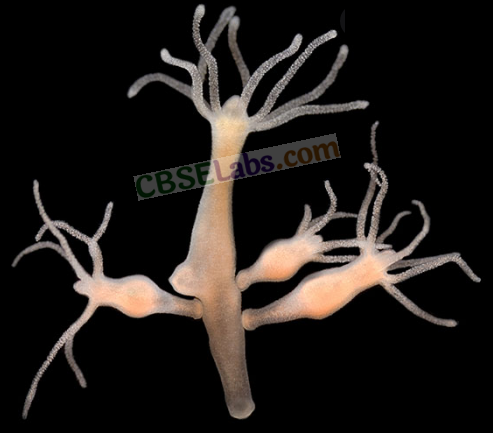
8. Budding:
Organisms such as Hydra use regenerative cells for reproduction in the process of budding. In Hydra, a bud develops as an outgrowth due to repeated cell division at one specific site. These buds develop into tiny individuals and when fully mature, detach from the parent body and become new independent individuals.
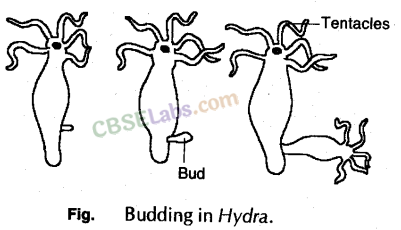
9. Spore Formation (Sporulation):
Some bacteria and lower organisms make spores. During spore formation, knob like structure called sporangium develops from the fungal hypha. Sporangia contain spores that eventually develop into new individual. The spores are covered by thick walls that protect them until they come in contact with moist surface or substratum and can begin to grow.
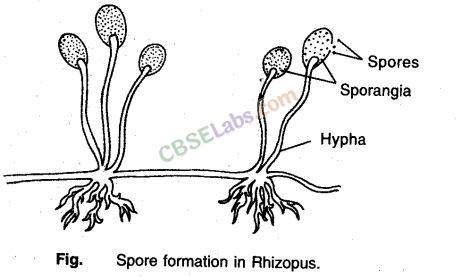
10. Fragmentation : It can be seen in Spirogyra. During this process filament of spirogyra simply breaks up into smaller pieces upon maturation. These pieces or fragments grow into new individuals. This process occurs under favourable conditions of moisture, temperature, light and nutrient availability.
11. Vegetative propagation:
It is the simplest method of reproduction in some higher plants in which new plant is produced from any vegetative part of the plant such as root, stem, leaf, etc.
Advantages of vegetative propagation :
Vegetative propagation is useful for plants those have lost the capacity to produce seeds, e.g. banana, rose, jasmine. Moreover, all plants produced are genetically similar to the parent plant.
Natural Vegetative Propagation:
In some plants like guava, sweet potato, dahlia, roots sprout and grow into new plants during favourable conditions. In some other,stems grow horizontally and develop root below and leaves above the ground. Many other common examples of vegetatively propagating plants are onion, banana, garlic, ginger, turmeric, bryophyllum and water hyacinth.
12. Vegetative propagation in Bryophyllum:
Bryophyllum reproduces by the vegetative propagation method. During this method, buds produced in the notches along the leaf margin of bryophyllum fall on the soil and develop into new plants.
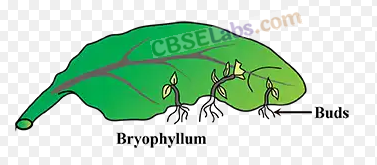
13. SEXUAL REPRODUCTION :
Sexual reproduction involves two individuals for producing a new individual. Sexual reproduction begins with fertilization, which is defined as the union of two different gametes. The motile germ-cell fptrUeh or sperm) is called the male gamete and germ-cell containing stored food (egg or ovum) is called the female gamete. The process of fusion of two gametes is called fertilization. After fertilization, a zygote is formed , which develops into a new organism.
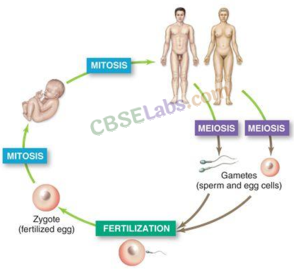
14. Sexual reproduction in Plants :
The flowering plants or angiosperms bear special reproductive parts located in the flower. Various parts of flower are; sepals, petals, stamens and carpels.
Most flowers have both male and female reproductive organs. The flower may be unisexual (papaya, watermelon) when it contains either stamen or carpel or bisexual (Hibiscus, Mustard) when it contains both stamens and carpels. It has male reproductive part cal led stamen and a female reproductive part called carpel. Carpel is made of three parts. The swollen bottom part is the ovary, middle elongated part is the style and the terminal part which may be sticky is the stigma.
The ovary contains ovules and each ovule has an egg cell. Each stamen consists of stalk called filament, and a flattened fertile top called anther. The anthers produce the pollen grains. The pollen grains produce male gametes which fuse with (egg cel I) female gamete present in the ovule. This fusion of the germ-cells or fertilization gives zygote which grows into a new plant. Pollination: It is the process of transfer of pollen grains from the anther to the stigma of flower. If this transfer of pollen occurs in the same flower, it is referred to as self-pollination, whereas if the pollen is transferred from one flower to another, it is known as cross-pollination. This transfer is carried out by different agencies like wind, water, insects or animals.
Fertilization: A tube grows out of pollen grain and travels through the style to reach the female germ-cells present in ovule in the ovary. Out of two male gametes present in pollen tube one fuses with egg to form zygote. This fusion is called fertilization. After fertilization, the zygote divides several times to form an embryo within the ovule. The ovule develops a tough coat and gradually turns into a seed. The ovary grows rapidly and ripens to form a fruit. Meanwhile the petals, sepals, stamens, style and stigma may shrivel and fall off.
15. Reproduction in human beings : The reproductive organs of human beings are called gonads. These are testes in male and ovaries in female. The male gonad produces sperms and female gonad produces ova (eggs) at the age of puberty (after attainment of sexual maturity). Various changes occur in girls and boys at this age.
16. Male Reproductive System consists of the following organs:
Testes: A pair of testes are situated in scrotum that lie outside the abdominal cavity and behind the penis. Testes produce sperms and hormone, Testosterone hormone. Testosterone brings about changes in appearance of boys at the time of puberty.
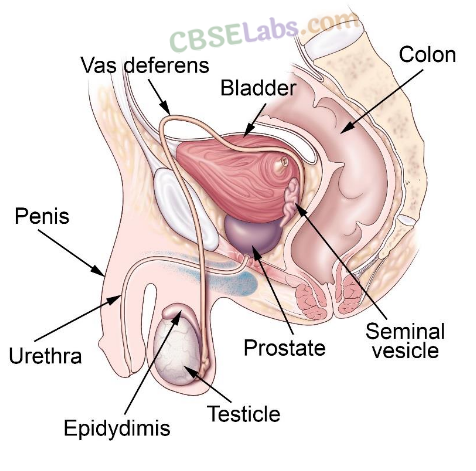
VAS deferens:
From each testis, a duct arises which is known as vas deferens which unites with a tube coming from urinary bladder. It brings sperms from testis.
Urethra: Vas deferens tube opens into a common tube called urethra. It runs through a muscular organ called Penis. Penis is male copulatory organ.
Accessory Glands: Glands like prostate and seminal vesicles and Cowper’s gland add their secretions which make transport of sperms easier and this fluid also provides nutrition.
17. Female Reproductive System:
It consists of the following organs:
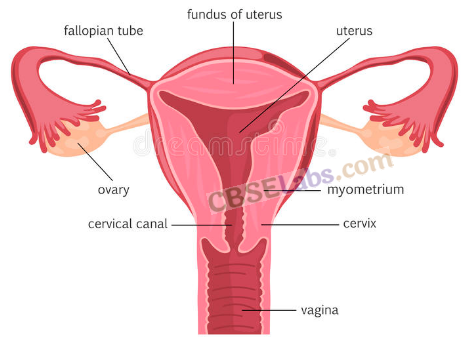
Ovaries:
Paired ovaries are located in the abdominal cavity near the kidney. Ovaries produce female gamete (ovum or egg) and secrete female hormones (estrogen and progesterone). One egg is produced every month alternately by one of the ovaries.
Fallopian Tube:
The egg is carried from the ovary to womb/uterus through a thin oviduct or fallopian tube.
Uterus:
The two oviducts unite into an elastic bag like structure known as the uterus.
Vagina:
Uterus opens into the vagina. It is a female copulatory organ.
18. Sexual Cycle in female: After puberty, only one egg is produced alternately from one ovary after a period of 28 days. Egg in fallopian tube encounter sperms which enter through the vaginal passage during sexual intercourse. This fertilized egg (zygote) gets implanted in the lining of uterus which later forms embryo. Embryo gets nutrition from the mother’s blood with the help of special tissue called placenta.
If the egg is not fertilized, if lives for about one day since the ovary releases one egg every month, the uterus prepares itself every month to receive the fertilized egg. Thus, its lining becomes thick and spongy. If it does not get zygote, the developed lining slowly breaks down and comes out through the vagina as blood and mucus. This cycle takes place roughly every month and is known as menstruation. It usually lasts for about 2-5 days.
19. Reproductive Flealth: Reproductive organs need a lot of care and hygiene. Otherwise, they are susceptible to many infections or diseases. The diseases which spread through sexual routes are known as sexually transmitted diseases e.g., bacterial infections like syphilis, gonorrhoea and viral infections such as warts and HIV- AIDS. A condom helps to prevent transmission of many of these infections to some extent.
Frequent pregnancy causes many health problems and also adds to an already exploding population. Many ways have been devised to avoid pregnancy. Contraception can be achieved by:
- Mechanical barrier method (use of condoms).
- Chemical methods (use of pills).
- Use of contraceptive devices (copper-T).
- Surgical methods (vasectomy in males and tubectomy in females)
Class 10 Science Notes
- Chapter 1 Chemical Reactions and Equations Class 10 Notes
- Chapter 2 Acids Bases and Salts Class 10 Notes
- Chapter 3 Metals and Non-metals Class 10 Notes
- Chapter 4 Carbon and its Compounds Class 10 Notes
- Chapter 5 Periodic Classification of Elements Class 10 Notes
- Chapter 6 Life Processes Class 10 Notes
- Chapter 7 Control and Coordination Class 10 Notes
- Chapter 8 How do Organisms Reproduce Class 10 Notes
- Chapter 9 Heredity and Evolution Class 10 Notes
- Chapter 10 Light Reflection and Refraction Class 10 Notes
- Chapter 11 Human Eye and Colourful World Class 10 Notes
- Chapter 12 Electricity Class 10 Notes
- Chapter 13 Magnetic Effects of Electric Current Class 10 Notes
- Chapter 14 Sources of Energy Class 10 Notes
- Chapter 15 Our Environment Class 10 Notes
- Chapter 16 Management of Natural Resources Class 10 Notes